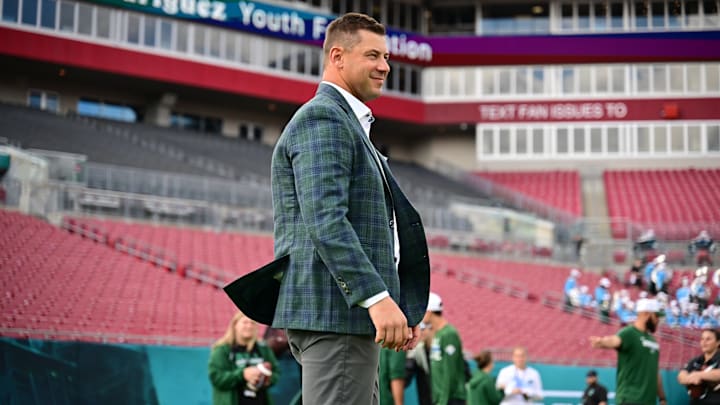AAC Commissioner Ready for Strong Fight To Keep Tulane Football Amid Pac-12 Rumors

In this story:
The American Athletic Conference has been a prime target of poaching in conference realignment for college football, and the Tulane Green Wave are a potential target in the next wave.
Tulane football was courted alongside AAC members Memphis Tigers, USF Bulls and UTSA Roadrunners in the initial attempts by the Pac-12 Conference to solidify their goal as the top Group of 5.
Commissioner Teresa Gould may revisit the talks that failed to result in a solid negotiation last September.
While the Pac-12 has prioritized solidifying a media rights agreement over expansion in the imminent future, they’ll need one more football member by July 2026 to be considered a conference in compliance with NCAA rules.
After that deal is secured—presumed to be in place around spring—Gould and the new Pac-12 Conference will need to secure at least one final member.
As Jon Wilner of the Mercury News reports, there are two strategies they could choose to employ; double down on regional presence by securing more West Coast schools or circle back to those once invited out of the AAC.
Should the latter transpire, American Athletic Conference commissioner Tim Pernetti is poised to battle to retain the coveted four programs once again.
Pernetti was candid about the Pac-12's efforts to pick off the stronger members of his conference in a recent appearance on the Canzano and Wilner podcast, and that the move didn’t surprise him.
“I don’t know that I expected it from one conference or the other, but I expected it,” Pernetti said. “Why? Historically, the AAC has been a breeding ground that has built strong programs. We’re always walking around with a target on our back.”
While he admits it was a hectic couple of weeks riddled with chaos, he leaned on his decision-making that guided him to a successful retention of the programs.
“You can decide to do one of two things,” Pernetti explained. “You can go into full sales mode and talk about why you’re better and why the other guy’s no good. Or you can act more like a partner and a consultant, and that’s what we chose to do.”
Pernetti understands it’s the name of the game in today’s landscape of college football. He led efforts as the Rutgers Scarlet Knights athletic director to join the Big Ten in early 2010. That helped him implement a strategy that fended off the Pac-12 in the first wave.
“Institutions vetting what’s out there to see what’s best for their school, that’s their job. I wasn’t upset about it,” Pernetti said. “What we did was we made sure to surround those four schools with experts and expertise so they could separate fact from fiction and make sure they were dealing with information that enabled them to make the decision.”
The points Pernetti made are sage.
While programs covet more and more revenue and resources, they often neglect important things in the process.
“Think about student-athletes now that are traveling across the country just to compete in conference competition,” Pernetti continued. “Is that the best-case scenario for the student-athlete experience? I don’t think it is—and don’t think I didn’t share that. When our schools asked me about expansion opportunities, I said to make sure you think about the student-athlete experience.”
The other sticking point was unclear revenue with no secured media rights deal on the table at the first round of negotiations. The Pac-12 could only give projections back in September without any negotiations taking place.
Programs that require travel to the West Coast may find it difficult to justify, as the intangible costs can be equally devastating. Time changes, long flights and diminished practice time do not serve the athletes' best interests without a stronger offset than the first offer.
A second run at the four schools would undoubtedly include a deal in place and have value to be negotiated. It would have to cover hefty exit fees, believed to be around $25 million per school.
If Memphis, Tulane and USF all receive $10 million from their larger AAC distributions, how much would it take for them to make the jump?
Would a range between $12 to $15 million suffice?
Pernetti is impressed by the solidarity displayed by the conference members in their show of support publicly last year.
“The unity of the AAC is actually a real thing right now,” Pernetti said. “But I’m not a fool, OK? I know as long as conferences are thinking about the future,” realignment will continue.
“This is like hurricane season. We had it in September, and it’s going to come back around. It’s inevitable, and you can’t predict when it’s going to hit. You just have to be prepared for it.”
Recommended Articles

Maddy Hudak is the deputy editor for Tulane on Sports Illustrated and the radio sideline reporter for their football team. Maddy is an alumnus of Tulane University, and graduated in 2016 with a degree in psychology. She went on to obtain a Master of Legal Studies while working as a research coordinator at the VA Hospital, and in jury consulting. During this time, Maddy began covering the New Orleans Saints with SB Nation, and USA Today. She moved to New Orleans in 2021 to pursue a career in sports and became Tulane's sideline reporter that season. She enters her fourth year with the team now covering the program on Sports Illustrated, and will use insights from features and interviews in the live radio broadcast. You can follow her on X at @MaddyHudak_94, or if you have any questions or comments, she can be reached via email at maddy.hudak1@gmail.com